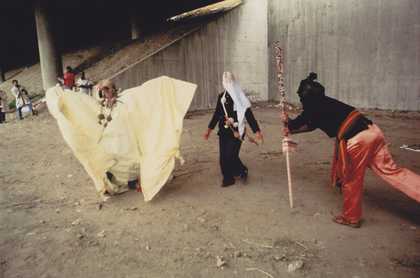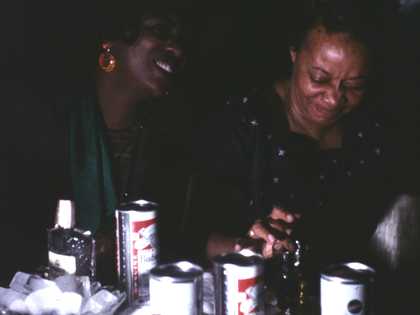Registering relatives, friends and peers in their own environments, these two filmic portraits are marked by their subjective qualities and senses of ease, intimacy and respect. Each develops specific formal approaches to animate their portraits and draw subjects together.
Edward Owens Remembrance: A Portrait Study 1967, 16mm transferred to digital, colour, sound, 6 min
Remembrance: A Portrait Study is a filmic portrait of the artist’s mother, Mildered Owens, and her friends Irene Collins and Nettie Thomas, set to a score of 50s and 60s hit songs. Using Baroque lighting techniques, Owens captures the three women drinking and lounging one evening.
‘The music is by Marilyn Monroe singing ‘Running Wild’ from Some Like It Hot, because it’s a film portrait of Nettie Thomas. She did floors in white women’s homes, like black women did to support their families in the olden days. My mother is sitting in a wicker chair with an ostrich feather boa, a grey worsted wool skirt, a silk belt. For her portrait, I used ‘All Cried Out’ by Dusty Springfield…I was advised by Gregory Markopoulos not to play the music. Because Gregory didn’t think it was proper.’
Barbara McCullough Shopping Bag Spirits and Freeway Fetishes: Reflections on Ritual Space 1981, video, colour, sound, 60 min
Shopping Bag, Spirits and Freeway Fetishes: Reflections on Ritual Space portrays nine Los Angeles-based African American artists as they reflect on the role of ritual in their life and art. Artist David Hammons discusses the importance of chance and improvisation in his work while working on sculpture on a waste site, while N’Senga Nengudi talks about feeling possessed while staging her performances in freeway underpasses. Spanning performance to spoken word, environmental sculpture to music, each artist reflects on their creative processes and the ways in which cultural traditions come to inform their work. Seeking to adjust the criteria and language used to talk about artists of colour,
this experimental essay weaves together interviews, documentation and photographs, intercut with the music of Don Cherry.

Barbara McCullough Shopping Bag Spirits and Freeway Fetishes: Reflections on Ritual Space 1981, film still. Courtesy the artist and UCLA Film & Television Archive

